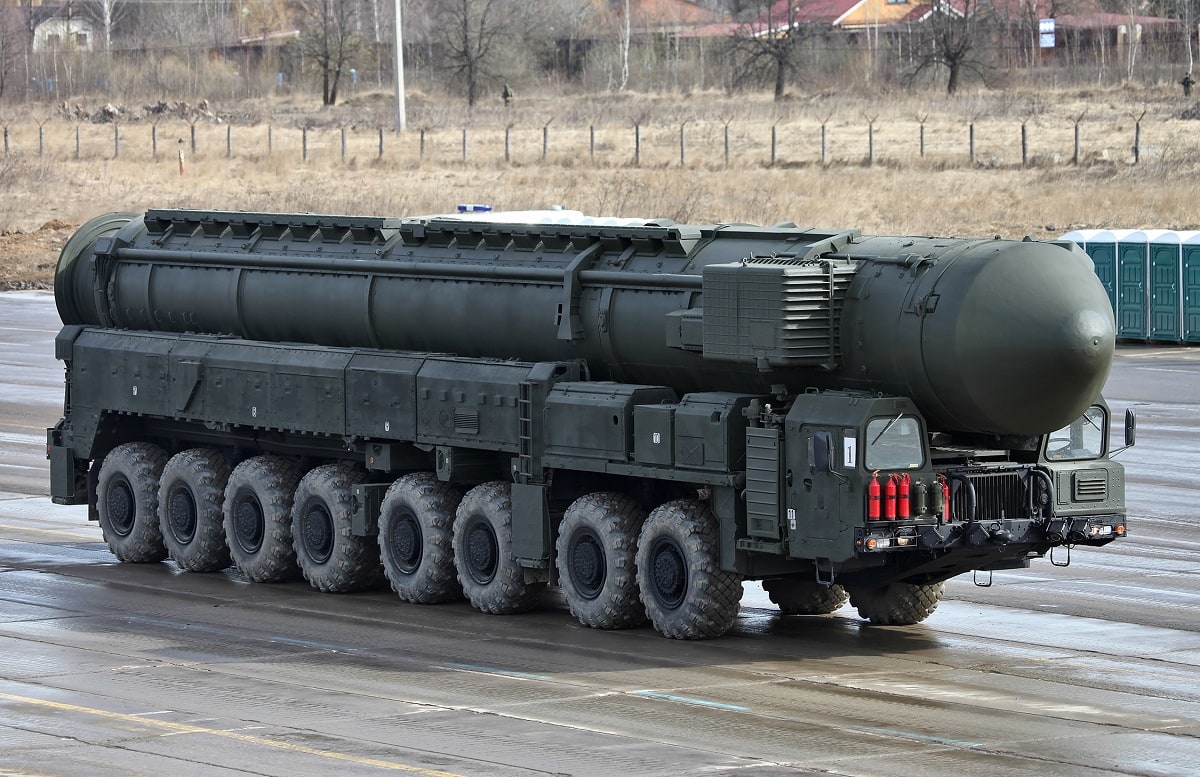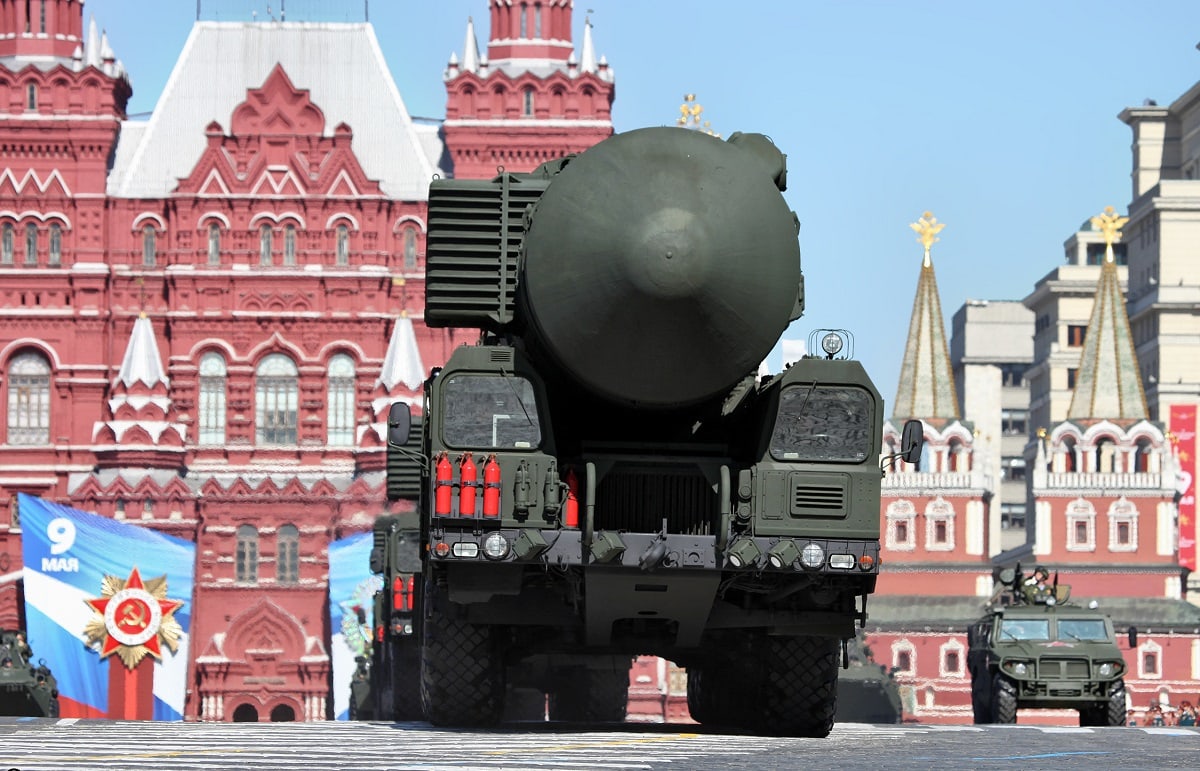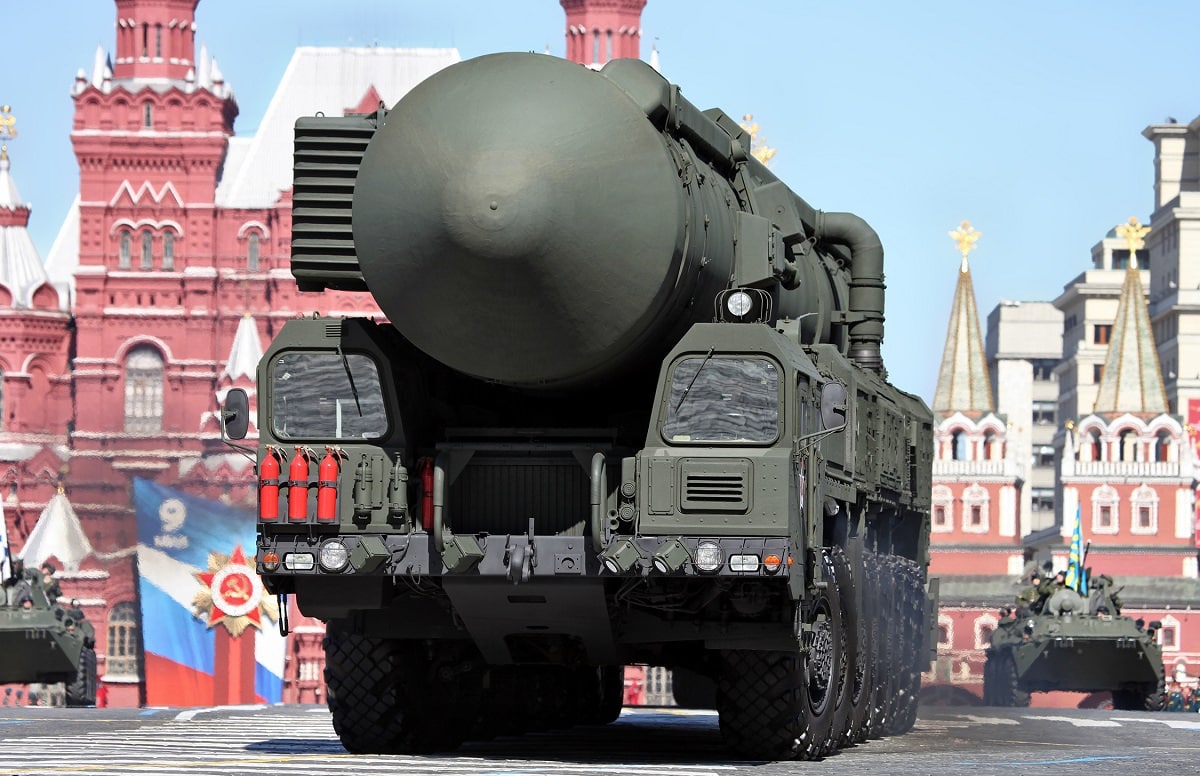In April 2021, noted Russian journalist Pavel Felgenhauer wrote, “Indeed, taking into account nonstrategic (tactical) nuclear weapons, which no one has ever verifiably counted, Russia may have more (maybe twice as many overall) than all the other official or unofficial nuclear powers taken together.” He may be correct, although at the rate the Chinese are building, this won’t last very long. As General Glen VanHerck, Commander of the U.S. Northern Command and the North American Aerospace Defense Command, has observed, “Russia is the primary military threat to the homeland today. It is not China—it is Russia.”
The combined Russian and Chinese strategic nuclear force may approach the peak Soviet level. As STRATCOM Commander Admiral Charles Richard has pointed out, “Today’s strategic environment is characterized by two nuclear-capable peers who wish to change the world order and one, the U.S., with our allies, that wants to defend that world order.” This should have major implications for the Biden administration Nuclear Posture Review, but this is unlikely.
Today, against this backdrop, I will be talking about Russia, which has the world’s lowest threshold for nuclear weapons first use. In June 2020, Putin signed an unclassified Presidential directive on nuclear deterrence. Pavel Felgenhauer noted, “First, the nuclear threshold is becoming lower…Moscow’s threshold for employing military force in conflict situations may also drop further.”
Putin announced four specific criteria for nuclear weapons first use in paragraph 19 of his directive:
19. The conditions specifying the possibility of nuclear weapons use by the Russian Federation are as follows:
a) arrival of reliable data on a launch of ballistic missiles attacking the territory of the Russian Federation and/or its allies;
b) use of nuclear weapons or other types of weapons of mass destruction by an adversary against the Russian Federation and/or its allies;
c) attack by an adversary against critical governmental or military sites of the Russian Federation, disruption of which would undermine nuclear forces response actions;
d) aggression against the Russian Federation with the use of conventional weapons when the very existence of the state is in jeopardy.
Paragraph 4 of the decree contains more nebulous language for nuclear first use. It reads:
…to guarantee the sovereignty and territorial integrity of the state and to deter a potential adversary from aggression against the Russian Federation and (or) its allies in the event of the emergence of an armed conflict by preventing the escalation of military activities and ending them on conditions acceptable to the Russian Federation and (or) its allies.
There are clearly classified aspects of Russian nuclear doctrine. In September 2014,General of the Army (ret.) Yuriy Baluyevskiy, a former Chief of the Russian General Staff who developed the 2010 revision of Russia’s nuclear doctrine when he was Deputy Secretary of the Russian National Security Council, stated that the “…conditions for pre-emptive nuclear strikes…is contained in classified policy documents.”[1] in 2015, President Vladimir Putin stated, “Fifty years ago, I learnt one rule in the streets of Leningrad: if the fight is inevitable, be the first to strike.”
Central to Russian nuclear strategy is the concept of “escalate to deescalate” or “escalate to win.” This was announced officially in 2003. The Obama administration brought this to widespread public attention starting in 2015. According to noted Russia expert Dr. Steve Blank, “…arguably [escalation dominance] is merely a part of a much broader nuclear strategy that relies heavily upon the psychological and intimidating component of nuclear weapons.” In 2017, then-Defense Intelligence Agency Director Lieutenant General Vincent Stewart informed the Congress that Russia is “…the only country that I know of that has this concept of escalate to terminate or escalate to deescalate, but they do have that built into their operational concept, we’ve seen them exercise that idea and it’s really kind of a dangerous idea…” He also said that he had seen no evidence that this policy was changing. In February 2021, Dr. Maxim Starchak, a fellow at the Centre for International and Defence Policy of Queen’s University U.K., observed that while Russia will not admit “…to escalation for de-escalation, but this is, in fact, what is going on.”
Russia clearly has many more nuclear weapons than the U.S. There is no recent official U.S. unclassified number for the total number of Russian nuclear weapons. In November 2011, the Obama administration estimated Russia had 4,000-6,500 nuclear weapons. Hans Kristensen and Matt Korda of the Federation of American Scientists said that “We estimate that approximately 1,800 [U.S.] warheads are currently deployed, of which roughly 1,400 strategic warheads are deployed on ballistic missiles and another 300 at strategic bomber bases in the United States. An additional 100 tactical bombs are deployed at air bases in Europe.” In 2020, they credited Russia with about 4,500 operational nuclear weapons. In March 2021, a German Defense Ministry document reportedly stated Russia has about 6,375 nuclear warheads ready for use. In December 2017, Bill Gertz reported, “Russia is aggressively building up its nuclear forces and is expected to deploy a total force of 8,000 warheads by 2026 along with modernizing deep underground bunkers, according to Pentagon officials. The 8,000 warheads will include both large strategic warheads and thousands of new low-yield and very low-yield warheads to circumvent arms treaty limits and support Moscow’s new doctrine of using nuclear arms early in any conflict.” In August 2019, then-Deputy Assistant Secretary of Defense for Nuclear Matters Rear Admiral (ret.) Peter Fanta confirmed the Gertz story stating that “The Russians are going to 8,000 plus warheads.”
In December 2019, Russian Strategic Missile Force Commander Colonel General Sergei Karakayev implied that Russia has over 3,300 strategic nuclear warheads. Most Russian nuclear weapons are nonstrategic or tactical nuclear weapons. The stockpile is very large, being modernized and is expanding. In 2014, Pravda.ru reported, “Russia, according to conservative estimates, has 5,000 pieces of different classes of TNW [tactical nuclear weapons] – from Iskander warheads to torpedo, aerial and artillery warheads!” The official Russian claim that it has reduced its tactical nuclear weapons 75% from Cold War levels equates to about the same number. Dr. Philip Karber, President of the Potomac Foundation, has stated that roughly half of Russia’s 5,000 tactical nuclear weapons have been modernized with new sub-kiloton nuclear warheads for air defense, torpedoes and cruise missiles. Certainly, the Vice Chairman of the Joint Chiefs of Staff General John Hyten’s statement that Russia has thousands of low-yield strategic and tactical nuclear weapons suggests something like this has happened. Russian expert Sergei Rogov has noted that assessments of Russian nonstrategic nuclear weapons range between several thousand and over 10,000.
In 2017, Russian Defense Minister General of the Army Sergei Shoigu stated Russia will “…continue a massive program of nuclear rearmament, deploying modern ICBMs on land and sea, [and] modernizing the strategic bomber.” In July 2021, he stated that 83% of Russian strategic nuclear forces had been modernized. In August 2021, Admiral Richard said that Russia was still the near-term pacing nuclear threat and has achieved 80-85% modernization of their strategic nuclear forces, and there was nothing they were not modernizing.
Russian modernization won’t end when it reaches 100%. Russia has announced over 20 new or modernized strategic nuclear systems. In February 2021, Admiral Richard pointed out:
The strategic capabilities of our competitors continue to grow, and they are sobering. More than a decade ago, Russia began aggressively modernizing its nuclear forces, including its non-treaty-accountable medium- and short-range systems. It is modernizing bombers, intercontinental ballistic missiles (ICBMs), submarine-launched ballistic missiles (SLBMs), nuclear-powered ballistic missile submarines, warning systems, command-and-control (C2) capabilities, and the doctrine to underpin their employment—in short, its entire strategic force structure. This modernization is about 70 percent complete and on track to be fully realized in a few years. In addition, Russia is building new and novel systems, such as hypersonic glide vehicles, nuclear-armed and nuclear-powered torpedoes and cruise missiles, and other capabilities. And its leaders have not been reticent to leverage these capabilities to coerce its neighbors. During the annexation of Crimea in 2014, President Vladimir Putin reminded the world of Russia’s nuclear weapon capabilities, both through words and deeds, to warn against any attempts at reversing the outcome.
Russia often brags about its new nuclear superweapons. In June 2021, President Putin declared, “Hypersonic weapons – the Avangard and Kinzhal (Dagger) complexes – have already been put on combat alert. Other unparalleled weapons systems, including Sarmat intercontinental ballistic missile, Zircon ship-based hypersonic missile, and the S-500 Prometheus anti-aircraft systems, to name just a few, are coming soon.”
Russia has said that the new Sarmat heavy ICBM will be operational in 2022. This is likely optimistic because it would require all planned tests to be on time and successful. What is most important is not the precise IOC but the plan with regard to numbers. In December 2019, Putin was told that Russia would deploy 20 regiments of its new Sarmat heavy ICBM by 2027.[6] This represents 120 to 200 silos, a large increase from the reported 46 that now exist for the SS-18 heavy ICBM. According to the Russian Ministry of Defense, the “…Sarmat will be able to carry up to 20 warheads of small, medium, high power classes.” It will also carry several of the hypersonic Avangard.
In December 2020, Colonel General Karakayev, Commander of the Strategic Missile Forces, said that the development of new ICBMs “…will begin in the short-and mid-term perspective.” In December 2020, TASS reported that a new missile called the Kedr would replace the RS-24 Yars ICBM starting in the 2030s. The Yars is reportedly capable of carrying up to six small warheads.[8] In January 2021, Izvestia indicated that the Yars-S with “medium yield warheads – are in the inventory right now.” For several years the Russians talked about deploying this missile but gave no indication of how it differs from the earlier version. In June 2021, a Russian publication called Military Chat wrote that, “Russia’s Moscow Institute of Thermal Technology (ITT) is carrying out research and design work for a new variant of the Yars-M ballistic missile known as Osina-RV…” It indicated it would provide an “an increased level of mission performance to meet modern requirements thanks to the use of new design solutions, technologies, component base, and software-methodology support.” It was also reported that “A developmental test of an as yet unidentified intercontinental ballistic missile (ICBM) was carried out in mid-June…” All of this is a classic example of how the Russians do business.
In August 2020, state-run RT reported, “Russian troops operate new ICBMs in mine and mobile versions. Different types of ICBMs have their own advantages. For example, mines are certainly better protected from being hit by cruise missiles or other air attacks. The rocket is located at a considerable depth and is protected by reinforced concrete caps…” There is nothing in the New START Treaty that deals with basing mobile ICBMs in underground tunnel facilities.
In December 2020, Russia announced that two Borei ballistic missile submarines would become operational in 2021 and two more (numbers 9 and 10) would be laid down. In August 2021, Putin announced they had been laid down. State-run Sputnik News said, “Russia could build more Borei-A class strategic ballistic missile submarines after it finishes the construction of ten such subs in accordance with the current contracts.” In August 2021, the 5th Borei submarine, a Borei-A, started sea trials. In 2018, TASS said that Russia planned 14 Borei ballistic missile submarines. In 2019, TASS indicated that Russia might develop and deploy two Borei-K strategic cruise missile submarines after 2027. Reportedly, the follow-on missile submarine, the Husky, while not canceled, is not currently being funded by the Russian Ministry of Defense.

Russia has been modernizing its bomber force with new stealth cruise missiles, modernizing the existing aircraft and the development and deployment of new bombers. In February 2021, General Shoigu stated, “In 2020, upgraded Tu-160M [usually referred to as Tu-160M2] and Tu-95MSM strategic missile-carrying bombers performed their debut flights.” Russian Deputy Defense Minister Alexey Krivoruchko said that Tu-160 will reach the troops by 2021 and that the Tu-160 force will be increased by more than 50% by 2027. He indicated that “…further expansion of the fleet of aviation complexes [Tu-160M2] is expected to be achieved within the framework of the new state armament program for 2024-2033.” The Russians plan at least 50 of the new version of the Tu-160.
In 2020, the new version of the Tu-95, the Tu-95MSM strategic missile-carrying bombers, performed their debut flights. According to TASS, “The Tu-95MS strategic missile-carrying bomber is designated to accomplish the tasks of striking vital targets in remote military-geographical areas and deep in the rear of continental theaters of military operations, employing nuclear missile weapons.”
There is also a new version of the Backfire called the Tu-22MSM now flying. Almost all Russian state-media outlets have reported activities related to the Backfire bomber that would violate the New START Treaty. This includes its association with the Kh-101 long-range cruise missile, which Russia says is nuclear-capable.
The Russians say the Pak DA is a stealth bomber and will carry long-range nuclear cruise and hypersonic missiles. State-run TASS indicated a “demonstration model” of PAK DA is supposed to be assembled by 2023. In January 2021, state-run Ria Novosti reported that the Russian Defense Ministry plans that the new Pak DA stealth bomber will enter service by the end of 2027.
Russia is developing and deploying a wide range of nuclear-capable hypersonic missiles. In addition to ICBM-range Avangard, the first regiment of which is operational and the second regiment will be operational in 2023[17], these include:
-The KH-32, an already operational near hypersonic nuclear-capable cruise missile (reported maximum speeds range from Mach 4 to Mach 5), with a range of 1,000-km.
-The already operational Iskander-M and the improved Iskander-M nuclear capable “aeroballistic” missiles with a reported maximum range of 700 to 1,000-km.
-The Kinzhal hypersonic “aeroballistic missile”[18], now operational, which when carried by the Mig-31 is capable of “delivering nuclear and conventional warheads in a range of over 2,000-km.” It is reportedly a derivative of the Iskander-M. The Kinzhal reportedly will be carried by the Tu-160. State-run TASS and Sputnik News say that the Backfire bomber will also carry the Kinzhal.[19] It possibly will be carried by the Su-34 long-range strike fighter.

Topol-M Missile – By Vitaly V. Kuzmin – http://vitalykuzmin.net/?q=node/498
-A smaller version of the Kinzhal to be carried by the Su-57 fighter aircraft. Reportedly, the new Checkmake fighter will be capable of internally carry any of the Su-57 weapons.
-President Putin says the Tsirkon (Zircon) powered nuclear capable hypersonic cruise missile has a range of over 1,000-km and a speed of Mach 9. A retired Russian admiral says the range is 2,000-km. It will soon be operational.
-The Kh-95 has been announced but not described. My guess is it is a longer-range air-launched version of the Tsirkon. State-run Sputnik News reported it was “set to be used as part of the modernized Tu-22M3M long-range bomber, the modernized Tu-160M strategic bomber and the so-called Prospective Aviation Complex for Long Range Aviation strategic bomber.”
There is substantial evidence, going back decades, and recently in the State Department’s non-compliance reports, that the Russians are conducting yield producing nuclear tests. These are contributing to Russian development of new nuclear weapons. Dr. Paul Robinson, former Director of the Sandia National laboratory, has said that sub-kiloton testing can result in confidence that nuclear weapons work. Absent testing, it is opinion.
In stark contrast to the Russia buildup of its nuclear forces, the U.S. has just begun an NPR which likely will further reduce our nuclear forces. In the context of the massive expansion of Chinese nuclear capability, this could be a national security disaster. Even before the discovery of the new Chinese silos and the Russian plan for 20 regiments of silo-based Sarmat ICBMs became public, a case could be made from a targeting standpoint for a strategic nuclear force of 2,700-3,000 nuclear warheads. There is a great difference between target coverage (assigning a warhead to a target) and damage expectancy (the probability of target destruction). Even the Global Zero “Commission” report planned on 2-on-1 strikes against every Russian and Chinese ICBM silo. This cannot be accomplished with current U.S. strategic forces much less a reduced one.
Dr. Mark B. Schneider is a Senior Analyst with the National Institute for Public Policy. Before his retirement from the Department of Defense Senior Executive Service, Dr. Schneider served in a number of senior positions within the Office of Secretary of Defense for Policy including Principal Director for Forces Policy, Principal Director for Strategic Defense, Space and Verification Policy, Director for Strategic Arms Control Policy and Representative of the Secretary of Defense to the Nuclear Arms Control Implementation Commissions. He also served in the senior Foreign Service as a Member of the State Department Policy Planning Staff.

